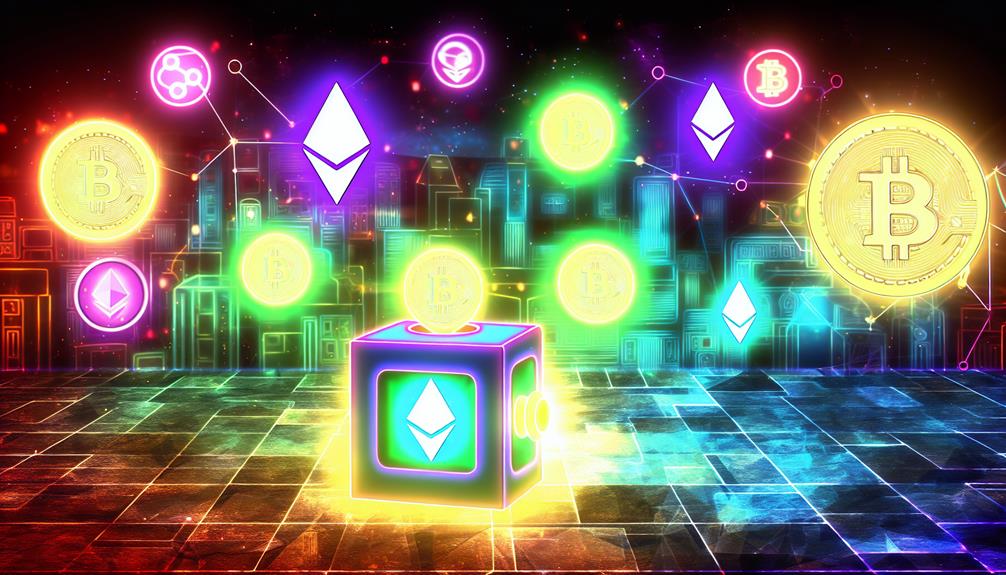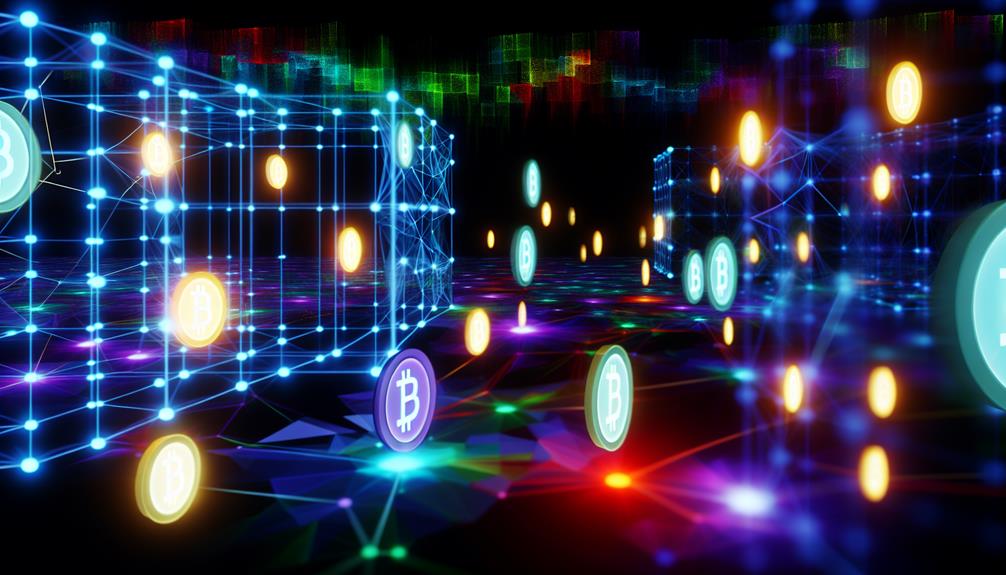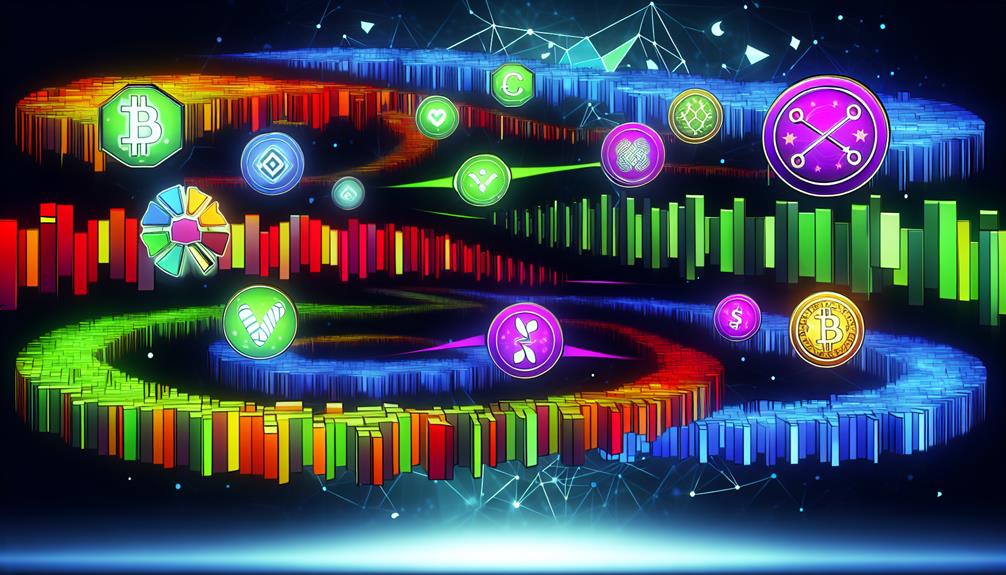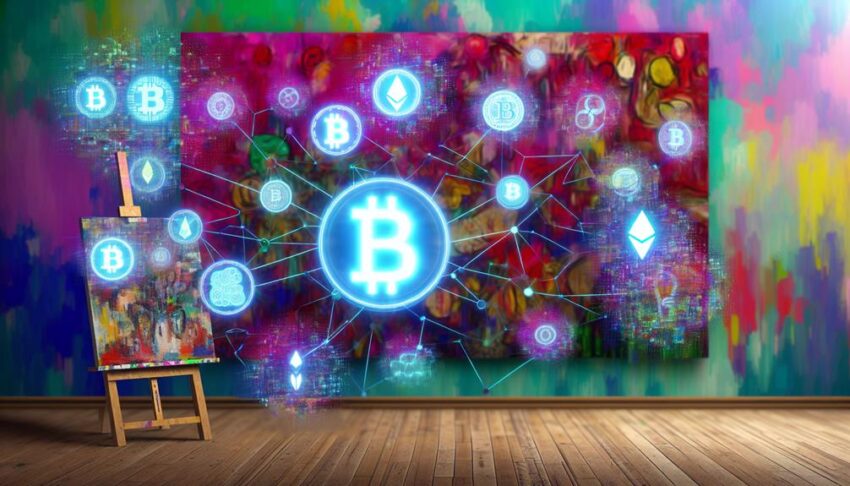When you think about minting an NFT, you're looking at a process that transforms a digital file into a distinct asset on the blockchain. It involves choosing a platform, entering metadata, and paying gas fees, which can fluctuate based on the network's current state. This process not only asserts your ownership but also opens avenues for monetizing your creativity. Yet, there's much more to reflect on about how this impacts artists and collectors alike, and the implications of minting on the broader digital landscape are worth exploring further.
Understanding NFTs

In the domain of digital assets, understanding NFTs (non-fungible tokens) is fundamental for grasping their significance and functionality. NFTs represent unique digital ownership through blockchain technology, distinguishing them from fungible assets like cryptocurrencies. This unique ownership fosters digital scarcity, an essential factor driving the value of NFTs in various markets. As an investor or creator, you'll need to analyze ongoing market trends to make informed decisions about NFT ownership.
NFTs have revolutionized creative expression, allowing artists to monetize their work directly through digital platforms. This shift not only empowers creators but also introduces the concept of artist royalties, ensuring that original creators benefit from future sales. However, it's important to evaluate the legal implications surrounding NFTs, including copyright rights and ownership disputes, as these can impact your investments or creations.
Additionally, there's growing concern regarding the environmental impact of NFTs, particularly due to the energy-intensive processes involved in maintaining blockchain networks. As a participant in this space, you should be aware of these issues and explore eco-friendly alternatives when engaging with NFTs.
Lastly, community engagement plays a significant role in the NFT ecosystem. By actively participating in discussions, collaborations, and partnerships, you can enhance your understanding of the market and potentially increase the value of your digital assets. Overall, grasping these elements will empower you to navigate the complex landscape of NFTs effectively.
The Minting Process
Minting NFTs is a vital step in the creation of digital assets, transforming artwork or other digital files into unique tokens on a blockchain. To initiate this process, you'll typically select a platform that supports NFT creation, such as OpenSea or Rarible. Once you've chosen a platform, you need to upload your digital file, which could be an image, video, or any other digital format.
Next, you'll encounter various minting techniques that cater to your specific needs. For instance, you might choose between lazy minting, where the NFT is created only upon its first sale, or traditional minting, where the NFT is generated immediately after you upload your file. Each method has its advantages, depending on your objectives.
After selecting your preferred technique, you'll be prompted to provide metadata for your NFT. This includes details like the title, description, and any other relevant attributes that make your asset unique. Once you've filled out this information, the final step involves confirming the transaction on the blockchain.
At this stage, it's essential to take into account gas fees, which are transaction costs required to validate and record your NFT on the blockchain. These fees can vary greatly based on network congestion, so you should be prepared for fluctuations in costs. Once you've successfully minted your NFT, it becomes a verifiable digital asset, ready for sale or trade within the growing NFT marketplace.
Blockchain Technology Overview

Blockchain technology serves as the backbone for NFTs and various digital assets, providing a decentralized and secure framework for transactions. At its core, blockchain is a distributed ledger technology that records transactions transparently across a network of computers. This decentralized ledger eliminates the need for intermediaries, allowing for peer-to-peer transactions that enhance security and trust.
Each transaction on the blockchain is grouped into blocks, which are then linked to form a chain. This structure guarantees that once data is recorded, it cannot be altered without consensus from the network, establishing immutability. You can think of it as a digital fortress where data integrity is paramount.
Smart contracts play a pivotal role in this ecosystem. These are self-executing contracts with the terms directly written into code, enabling automatic execution of agreements when predefined conditions are met. For instance, when you mint an NFT, a smart contract is triggered to verify ownership and authenticity, facilitating a seamless transfer of the asset without human intervention. This not only streamlines processes but also minimizes the potential for disputes.
The combination of decentralized ledgers and smart contracts creates an environment where trust is built into the system itself. You don't need to rely on a single entity to validate transactions, reducing the risk of fraud and enhancing efficiency. Understanding these foundational elements is essential as you explore the intricacies of minting NFTs and their implications in the digital asset landscape.
Benefits of Minting NFTs
The benefits of minting NFTs extend beyond mere ownership; they encompass a transformative shift in how digital assets are created, traded, and valued. By minting NFTs, you're not just creating a unique digital item but also asserting your digital ownership, which is vital in today's virtual landscape. This ownership is verifiable on the blockchain, enabling you to establish provenance and authenticity, which can greatly enhance the value of your creative expression.
Minting NFTs fosters community engagement, allowing artists to connect directly with their audience. This interaction can lead to collaborative projects and feedback loops that drive artistic innovation. As you participate in this ecosystem, you stay attuned to market trends, which can inform your future creations and potentially increase your revenue generation opportunities. The ability to monetize your work through NFT sales can provide financial sustainability, empowering you as a creator.
However, it's important to reflect on the environmental impact associated with minting NFTs. The energy consumption of blockchain networks can be substantial. By choosing platforms that prioritize eco-friendly practices, you can mitigate your carbon footprint while still reaping the benefits of this digital revolution.
Ultimately, minting NFTs not only elevates your creative expression but also positions you strategically within a rapidly evolving market that values digital ownership and innovation. As you navigate this landscape, you'll find that the benefits extend far beyond immediate gains, offering a lasting legacy in the digital domain.
Common Platforms for Minting

Exploring various platforms for minting NFTs reveals a diverse landscape tailored to different needs and preferences. Among the most popular marketplaces, OpenSea stands out due to its user-friendly interface and extensive reach. It allows you to mint NFTs directly on the Ethereum blockchain, but be prepared for varying minting fees that fluctuate based on network congestion. If you're looking for a more eco-friendly option, consider Rarible. This platform employs a proof-of-stake model, which notably reduces energy consumption, yet still charges minting fees based on the Ethereum gas prices.
Another notable platform is Mintable, which is designed for those who may not possess extensive technical knowledge. Its "Gasless Minting" feature enables you to create NFTs without upfront costs, although it does take a percentage when your NFT sells. For artists and creators looking for exclusivity, Foundation offers a more curated experience but requires an invitation to join, elevating your NFT's perceived value.
Additionally, platforms like Binance NFT and Polygon offer lower minting fees, appealing to budget-conscious creators. The choice of platform should align with your goals, whether it's maximizing exposure, minimizing costs, or ensuring environmental sustainability. Always consider the minting fees and the specific features of each marketplace, as they can notably impact your overall experience and profitability in the NFT space.
Future of NFT Minting
As the NFT landscape evolves, a multitude of trends and innovations are shaping the future of minting. You're likely to witness a significant market evolution driven by technological advancements and community engagement. The predicted trends indicate a shift towards more eco-friendly minting processes as sustainability concerns become paramount. Artists and creators are increasingly aware of the environmental impact of blockchain technology, leading to a rise in platforms that utilize energy-efficient mechanisms.
Here's a snapshot of emerging trends in NFT minting:
| Trend | Description |
|---|---|
| Eco-Friendly Platforms | Use of proof-of-stake and other sustainable methods. |
| Interoperability | NFTs that work across multiple blockchains. |
| Community-Driven Projects | Collaborative minting initiatives from diverse groups. |
| Enhanced User Experience | Simplified processes and better interfaces for minting. |
These trends open up creative opportunities for artists and developers alike. By leveraging emerging technologies, you're not just minting NFTs; you're contributing to a broader narrative that prioritizes sustainability and community involvement. As the market continues to mature, you'll likely see more collaborations aimed at driving engagement and innovation.
Frequently Asked Questions
Can Anyone Mint an Nft, or Do I Need Special Skills?
You don't need special skills to mint an NFT; most NFT platforms simplify the minting process. Familiarizing yourself with these platforms' interfaces and tools can help you navigate the process effectively and efficiently.
What Types of Digital Assets Can Be Minted as Nfts?
You can mint a treasure trove of digital assets, like stunning digital art, collectible items, virtual property, music tracks, gaming assets, domain names, photography prints, and sports memorabilia, each holding unique value in the digital domain.
Are There Any Environmental Concerns With Minting Nfts?
Yes, there are environmental concerns with minting NFTs, particularly regarding their carbon footprint. The energy-intensive process associated with blockchain sustainability raises questions about the ecological impact, prompting a need for more eco-friendly solutions in the industry.
How Much Does It Typically Cost to Mint an Nft?
The cost to mint an NFT varies considerably, influenced by cost factors like blockchain fees, artwork complexity, and gas prices. Pricing strategies can also impact overall expenses, making it essential to analyze each component carefully.
What Happens if I Lose Access to My Minted Nft?
If you lose access to your minted NFT, recovery options depend on the platform. Ownership rights may be compromised, but some services offer loss recovery solutions. Always secure your wallet to prevent such issues.
Conclusion
In the ever-evolving landscape of digital art, minting NFTs is like alchemy—transforming mere pixels into coveted treasures. By steering through the minting process, you're not just creating a token; you're forging a unique digital identity on the blockchain. As you explore platforms and manage gas fees, remember that each mint is a step toward ownership and innovation. In this brave new world, the potential for artists and collectors alike is as boundless as the digital cosmos itself.
